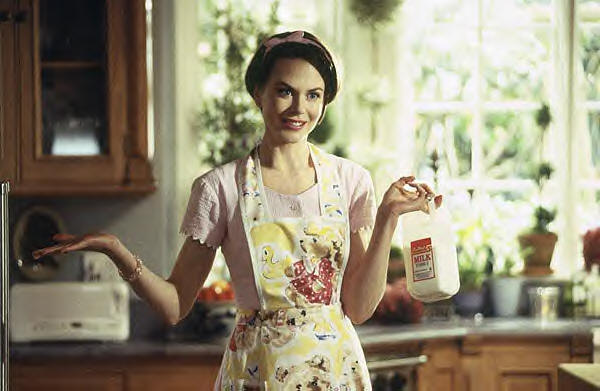The Stepford Wives
Reviewed by Rich Drees
 Before you even sit down in the theatre with your popcorn and soda, you know
the main plot twist of The Stepford Wives. It’s not just that the
film’s trailers have given it away, as most trailers seem to divulge too
much story information these days. It’s that the original 1973 film, based
on a novel by Ira Levin, made such an impression that even the phrase
“Stepford Wife” has now become part of our lexicon. So why remake a film
that depends on a surprise that everyone knows in advance? That’s a question
the makers of The Stepford Wives should have asked themselves before
they went through all the bother of making the film.
Before you even sit down in the theatre with your popcorn and soda, you know
the main plot twist of The Stepford Wives. It’s not just that the
film’s trailers have given it away, as most trailers seem to divulge too
much story information these days. It’s that the original 1973 film, based
on a novel by Ira Levin, made such an impression that even the phrase
“Stepford Wife” has now become part of our lexicon. So why remake a film
that depends on a surprise that everyone knows in advance? That’s a question
the makers of The Stepford Wives should have asked themselves before
they went through all the bother of making the film.
Joanna Eberhart (Nicole Kidman) is a driven television network executive,
who is fired after a disgruntled, gun-wielding contestant from one of her
reality shows disrupts the big unveiling of the network’s fall lineup.
Feeling that the a change of environment would be best, her husband Walter
(Matthew Broderick) moves the family to the sleepy little gated community of
Stepford, where we are told there is “ no crime, no poverty and no pushing.”
A jaded New Yorker, Joanna is more than a little disturbed that all the
women of Stepford seem to be blonde perpetually chipper and more than a
little subservient to their husbands. She joins forces with two other
recently transplanted Manhattanites, author Bobbi Markowitz (Bette Middler)
and one half of Stepfords first same sex couple Roger (Roger Bart), to try
to discover Stepford’s dark secret. Meanwhile, Walter spends an inordinate
amount of time at the Stepford Men’s Association where the charismatic Mike
(Christopher Walken) may hold the key to Stepford’s mysteries.
One would think that with such a line up of talented actors that The Stepford Wives would be a comedy goldmine. Unfortunately, the film only offers up feldspar, Fool’s Gold. Kidman monstrously overacts most of the early scenes of her character’s mental breakdown. Broderick’s performance contains none of the spark he is capable of delivering. Walken could probably give his trademarked subtly menacing performance in his sleep, and here it appears he has. But for all the bad performances nothing outshines the truly dreadful work by the participants of the film’s “Six months later” coda.
So what happened to cause a movie that looked so good on paper to turn out so badly? There have been many stories circulating of how this film’s shoot turned into the stuff great tell-all books are made from. Clashing egos and conflicting visions turned what should have been a three-month production into an eight-month one. Some wanted the film to be closer to its science-fiction thriller roots while others wanted it to be a silly suburban satire. Reportedly Walken was unhappy with his character’s fate as written in the script. (Didn’t he bother to read it before singing onto the project?) The film’s climactic ballroom sequence took a month to film- two weeks for one ending, two for a completely different ending. There was even reports that pickup shots were still being done a mere five weeks before its premier. This could explain why the film turned out to be such a mess. For every moment of comedy that works, two or more fall flat. The film starts off in a comedic vein, but it never gets edgy enough to be considered a dark comedy. The final half hour of the film abruptly shifts into thriller mode. The finale is a confusing mess. Is the film satirizing men and their desire to have a controllable mate? The idea of the perfect homemaker? Sadly, the only question audiences will leave the theatre is why did anyone bothered making this film at all.